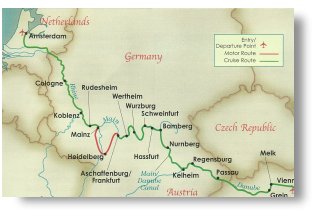
From Amsterdam, Holland to Vienna, Austria
September 15 to October 6, 2001

We began our trip with three days in Belgium and The Netherlands before embarking on our riverboat journey for 16 days, and ended with three days touring Vienna, Austria. In most of the towns we toured we had local guides, though we did have three program directors traveling with us who did some of the tours. While based at a hotel in Brussels we toured parts of The Netherlands: Antwerp, Delft, and Bruges.  Brussels was once a sleepy village that grew up around a chapel on an island in the Senne River, but now it is a thriving small capital city and the headquarters of NATO and the European Union. Only Geneva has more international headquarters than Brussels. We first had a short walking tour to the Grand Place (pronounced Gran Plas), the famous market square and heart of medieval Brussels that is dominated by a 15th century town hall with hundreds of little statues and many 17th century buildings and guild houses, all with gold inlays. We then took a motorcoach tour through the city and saw buildings of the European Union and the Atomium, an enormous steel construction representing an iron atom with nine spheres connected by corridors. It was HUGE, as you will see in the album picture; notice the people walking near it look dwarfed. We also stopped at the Army museum (built 1875-1880) and since it was Monument Day there was an outdoor demonstration of some of their military equipment. In historic times, guards at the watchtower on the square were required to ring the bell hourly to show they were awake.
Brussels was once a sleepy village that grew up around a chapel on an island in the Senne River, but now it is a thriving small capital city and the headquarters of NATO and the European Union. Only Geneva has more international headquarters than Brussels. We first had a short walking tour to the Grand Place (pronounced Gran Plas), the famous market square and heart of medieval Brussels that is dominated by a 15th century town hall with hundreds of little statues and many 17th century buildings and guild houses, all with gold inlays. We then took a motorcoach tour through the city and saw buildings of the European Union and the Atomium, an enormous steel construction representing an iron atom with nine spheres connected by corridors. It was HUGE, as you will see in the album picture; notice the people walking near it look dwarfed. We also stopped at the Army museum (built 1875-1880) and since it was Monument Day there was an outdoor demonstration of some of their military equipment. In historic times, guards at the watchtower on the square were required to ring the bell hourly to show they were awake.
In the afternoon we were on our own to wander as we pleased...and that we did! We decided to not go back with our motorcoach, but to walk around, and got a little lost trying to find our way back to the hotel. We eventually found a policeman who gave us directions. In the process of trying to find our way, we came across a tower and part of a wall that were built in the year 1100. The wall is integrated into the building behind it. We toured the lace and chocolate shops at the Grand Place and visited the flower mart. We were fortunate to see an interesting parade. In the evening our group had a "welcome dinner" at a restaurant overlooking the Grand Place.
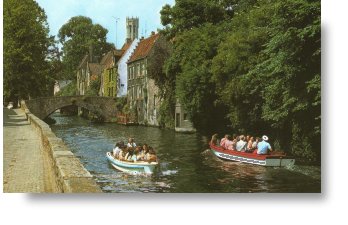 The next day we had a walking tour of Bruges along with a boat ride on the canals of the city known as the Venice of the North. These canals connect to the North Sea. Aside one of these canals is a museum that used to be St. John's Hospital, built in 1146...it looked a bit different from the St. John's Hospital where Dale practiced! We also visited a section called "baguinage" (translation is "veil") that was home to single women and widows or spouses of knights who went off to the Crusades. It was built in 1246 and is now a geriatric hospital. We also walked down the narrowest street in the city, formerly the red light district of Bruges. We had a talk and demonstration on chocolate making (and a taste test), and had a very informative talk and demonstration of lace making in a lace shop. It's amazing how quickly the ladies' fingers move when making lace by hand. The majority of lace makers are blind later in life due to the eyestrain of the making of the delicate lace pieces. We toured a cathedral that took 300 years to complete, finished in the 17th century, and it had a baroque pulpit, also from the 17th century. It houses a white statue of Madonna and Child that is the only statue by Michaelangelo that was exported during his lifetime. In Bruges, 50% of the residents are involved in the tourist trade.
The following day we left by motorcoach, stopping in Antwerp and Delft on our way to Amsterdam and our riverboat.
The next day we had a walking tour of Bruges along with a boat ride on the canals of the city known as the Venice of the North. These canals connect to the North Sea. Aside one of these canals is a museum that used to be St. John's Hospital, built in 1146...it looked a bit different from the St. John's Hospital where Dale practiced! We also visited a section called "baguinage" (translation is "veil") that was home to single women and widows or spouses of knights who went off to the Crusades. It was built in 1246 and is now a geriatric hospital. We also walked down the narrowest street in the city, formerly the red light district of Bruges. We had a talk and demonstration on chocolate making (and a taste test), and had a very informative talk and demonstration of lace making in a lace shop. It's amazing how quickly the ladies' fingers move when making lace by hand. The majority of lace makers are blind later in life due to the eyestrain of the making of the delicate lace pieces. We toured a cathedral that took 300 years to complete, finished in the 17th century, and it had a baroque pulpit, also from the 17th century. It houses a white statue of Madonna and Child that is the only statue by Michaelangelo that was exported during his lifetime. In Bruges, 50% of the residents are involved in the tourist trade.
The following day we left by motorcoach, stopping in Antwerp and Delft on our way to Amsterdam and our riverboat.
We visited Antwerp's Old Town section and had lunch outdoors on the central plaza. After lunch we toured the Delft Porcelain Factory and watched an artist creating a small mural-type porcelain piece. The process of creating the famous Delft porcelain was demonstrated. After a couple of purchases from their "convenient gift shop" we were on our way. Almost every town square we saw in any of the towns we visited had a fountain, and Antwerp's was built in the 17th century. Antwerp's cathedral took 350 years to build.
We arrived at our riverboat late in the afternoon, got settled in for the next two weeks and rested a bit, still trying to catch up from jetlag.  After dinner on our riverboat, a few of us walked into Amsterdam and toured the famous Red Light District, which is very much alive and going strong. We spent the night on our riverboat, and in the morning our city tour of Amsterdam included the Van Gogh Museum that contains the largest Van Gogh collection in the world, 200 paintings and 500 drawings. There were also creations by Gaughin, Monet, Toulouse-Lautrec and others. We also saw the home where Anne Frank lived that is now a museum. Here are a few facts we found interesting about Amsterdam: there are 195 museums, 95% of their products are recycled, there are 2200 houseboats, and the city burned three times so the majority of the newer buildings are brick. Homes are taxed on the width at street level, so the upper stories got wider as they built the second and third stories. While having lunch on the riverboat, we set sail for Cologne.
After dinner on our riverboat, a few of us walked into Amsterdam and toured the famous Red Light District, which is very much alive and going strong. We spent the night on our riverboat, and in the morning our city tour of Amsterdam included the Van Gogh Museum that contains the largest Van Gogh collection in the world, 200 paintings and 500 drawings. There were also creations by Gaughin, Monet, Toulouse-Lautrec and others. We also saw the home where Anne Frank lived that is now a museum. Here are a few facts we found interesting about Amsterdam: there are 195 museums, 95% of their products are recycled, there are 2200 houseboats, and the city burned three times so the majority of the newer buildings are brick. Homes are taxed on the width at street level, so the upper stories got wider as they built the second and third stories. While having lunch on the riverboat, we set sail for Cologne.
Upon arrival in Cologne we met a local guide and took a walking tour of the city. Originally Cologne was a Roman settlement called Colonia Agrippina after A.D. 50, and in the 5th century came under Frankish control. Cologne was built to honor the Three Magi. On the cathedral grounds is an arch built by the Romans in the 4th century. No mortar was used, and it has survived wars and weather. The cathedral was started in 1248, construction stopped in the mid-16th century, started again in 1842 and was finally completed in 1880.
 Our next stop was Koblenz. In WW2, 80% of the city was destroyed, and today there is only one pre-WW2 building remaining and it was built in 1520. The ruling Hapsburg family lived in Koblenz, and in 1830 they threw a party that lasted from September until the next spring! We had a walking tour of this city, and we were docked within walking distance of the German Corner at the confluence of the Rhine and Mosel rivers. There is a statue of Emperor Wilhelm I on this corner, and from there one can see the Ehrengreitstein Fortress. It sits 118 meters above the Rhine, and dates to the year 1000. The original fortress, destroyed by the French, was rebuilt by the Prussians (1817-1832).
While walking around Koblenz, we were stopped by two American college girls who were delighted to hear someone other than each other speaking English. They were touring Europe and staying in the Ehrengreitstein Fortress, part of which has been turned into a youth hostel. On the Metterheim Museum is a face said to represent Luttar VonKobern - the eyes move back and forth, and when the clock strikes the hour, he sticks out his tongue! There was a class of school children anxiously awaiting the striking of the clock, as was everyone in our group.
One of our tour guides during this trip pointed to a couple of buildings and said that they were new...built in the 16th century. Everything is relative, we supposed.
Our next stop was Koblenz. In WW2, 80% of the city was destroyed, and today there is only one pre-WW2 building remaining and it was built in 1520. The ruling Hapsburg family lived in Koblenz, and in 1830 they threw a party that lasted from September until the next spring! We had a walking tour of this city, and we were docked within walking distance of the German Corner at the confluence of the Rhine and Mosel rivers. There is a statue of Emperor Wilhelm I on this corner, and from there one can see the Ehrengreitstein Fortress. It sits 118 meters above the Rhine, and dates to the year 1000. The original fortress, destroyed by the French, was rebuilt by the Prussians (1817-1832).
While walking around Koblenz, we were stopped by two American college girls who were delighted to hear someone other than each other speaking English. They were touring Europe and staying in the Ehrengreitstein Fortress, part of which has been turned into a youth hostel. On the Metterheim Museum is a face said to represent Luttar VonKobern - the eyes move back and forth, and when the clock strikes the hour, he sticks out his tongue! There was a class of school children anxiously awaiting the striking of the clock, as was everyone in our group.
One of our tour guides during this trip pointed to a couple of buildings and said that they were new...built in the 16th century. Everything is relative, we supposed.
The next morning we sailed to Rudesheim on what is said to be the most beautiful part of the Rhine, passing the Lorelei rock that rises 440 feet above the river. Ancient Germanic legend, drawing from Greek mythology, says a "woman-creature" enticed sailors with a song ~ to their destruction on the reef below the rock. We enjoyed a walking tour of the town, and an afternoon of retail therapy. We took a tram ride to the top of a hill, riding over acres of vineyards. We also saw Schloss Br�mersburg. Dinner was at a restaurant in Rudesheim, the center of Germany's wine production.
 The following day we toured Mainz and Heidelberg by motorcoach and walking tours, and met our riverboat in Aschaffenburg. In Mainz, the birthplace of Johannes Gutenberg, we toured the Dom Museum which houses the original Gutenberg printing press in a workshop duplicating the one in which he worked. No photos were allowed, and the manuscripts were in glass cases. The original Gutenberg Bible did not have chapter and verse divisions. We saw a demonstration using the Gutenberg printing press. The page printed on the press was given to a lucky person in our tour group. In Heidelberg we visited the ruins of a Gothic castle, and toured part of Heidelberg University. Heidelberg was not bombed in WWII. We saw a water fountain (complete with rainbow due to the time of day and where the sun was) that is made up of over 200 figurines representing Mardi Gras, with a man at the bottom is attempting to wash the confetti out of his wallet. We thought this statue of Gutenberg with a Mc Donald's behind it was worth photographing.
The following day we toured Mainz and Heidelberg by motorcoach and walking tours, and met our riverboat in Aschaffenburg. In Mainz, the birthplace of Johannes Gutenberg, we toured the Dom Museum which houses the original Gutenberg printing press in a workshop duplicating the one in which he worked. No photos were allowed, and the manuscripts were in glass cases. The original Gutenberg Bible did not have chapter and verse divisions. We saw a demonstration using the Gutenberg printing press. The page printed on the press was given to a lucky person in our tour group. In Heidelberg we visited the ruins of a Gothic castle, and toured part of Heidelberg University. Heidelberg was not bombed in WWII. We saw a water fountain (complete with rainbow due to the time of day and where the sun was) that is made up of over 200 figurines representing Mardi Gras, with a man at the bottom is attempting to wash the confetti out of his wallet. We thought this statue of Gutenberg with a Mc Donald's behind it was worth photographing.
Wertheim houses the ruins of one of the oldest large stone fortresses in southern Germany, dating to 1100, is at the confluence of the Tauber and Main rivers and was incorporated into Bavaria in 1815. In the afternoon we had a glass blowing demonstration on board our riverboat. Wursburg is surrounded by vineyards, and the Wursburg Castle dates to 704. This town had tremendous damage during WWII and among the remarkably restored buildings is the Residenz, the last and finest Baroque palaces built in Bavaria. After our tour we had a wine tasting at a local winery before reboarding our riverboat.
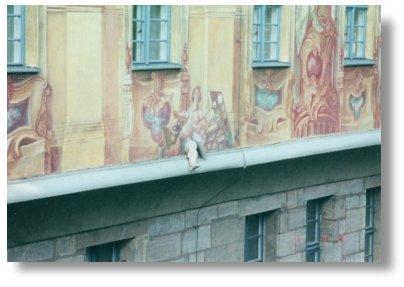 Next was Bamberg, one of Germany's most beautiful cities, dating to the year 902. Today it is a UNESCO World Heritage Site. There are several buildings still standing from Medieval times. Levi Strauss and Messerschmidt were born here. Our tour guide told us that in Bamberg, beer isn't alcohol - it's food! We saw a pharmacy that has been in business since 1437, just down a hill from Dom Fuhrung, a cathedral built in 1237. Bamberg is known as Little Venice, and is built on seven hills. We saw the residence of the Prince Bishop that has been used for that purpose since 600 A.D.
Next was Bamberg, one of Germany's most beautiful cities, dating to the year 902. Today it is a UNESCO World Heritage Site. There are several buildings still standing from Medieval times. Levi Strauss and Messerschmidt were born here. Our tour guide told us that in Bamberg, beer isn't alcohol - it's food! We saw a pharmacy that has been in business since 1437, just down a hill from Dom Fuhrung, a cathedral built in 1237. Bamberg is known as Little Venice, and is built on seven hills. We saw the residence of the Prince Bishop that has been used for that purpose since 600 A.D.
After breakfast the next day we took an excursion to Nurnberg, a medieval city surrounded by 13th century walls, and we saw the courthouse where the WW II war trials took place. It is the second largest city in Bavaria and the capital of Franconia. We also saw the Zepplin Grandstand, sans columns that have crumbled, where Hitler overlooked the 300-yard marching field. In the afternoon we had an on-board lecture on Germany after '45. While cruising this afternoon we crossed the European watershed, the highest point on the Main-Danube Canal. We all received a certificate commemorating the event.
The next morning we were in Kelheim and had toured the Weltenburg Monastery, a Baroque mixture of stucco, polished marble, gilt and painted ceilings. We rode a ferry through the Danube Gorge and met our riverboat to sail on to Regensburg, Germany's largest medieval city. We had a walking tour of Regensburg, and since the city suffered no damage during WW II it remains beautifully preserved. Regensberg has the most Italian towers outside Italy, and we saw Germany's oldest (850 years) stone bridge still standing. 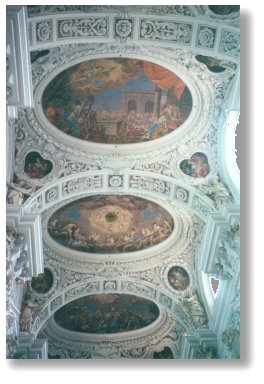 On our tour we walked under an arch built by the Romans in 179 A.D., and with its tower was the northern gate of the city. Our tour company had arranged for our group to have dinner in a local restaurant.
On our tour we walked under an arch built by the Romans in 179 A.D., and with its tower was the northern gate of the city. Our tour company had arranged for our group to have dinner in a local restaurant.
Our next stop was Passau, at the confluence of the Danube, the Ilz, and the Inn Rivers, and thus it is called the Dreiflussestadt (City on Three Rivers) and the Bavarian Venice. On our walking tour we saw the Bishop's Residenz, the 13th-century town hall, and other historic sites. In the afternoon some of us walked back into town and attended an organ concert. For many, many years the Passau Cathedral housed the largest church organ in the world (the largest is now in Salt Lake City) and has 233 stops (including four carillons) and 17,774 pipes. There are five separate organs in the cathedral. One is located above the ceiling fresco in the middle bay of the nave, and its sound comes in through an ornamental grate in the center of a painting on the ceiling. It was in Passau that I saw a street named Ludwigstrasse and had my picture taken standing by the street sign. For those of you who are wondering why in the world I would want my picture taken here, my maiden name is Ludwigson.
The following day we continued cruising the Blue Danube, stopping in Melk to tour its 900-year-old Baroque-style Benedectine monastery, perched high above the Danube on sheer cliffs. It was the inspiration for Umberto Eco's The Name of The Rose. It has 365 windows, one for every day of the year, was built in 1089, and covers more than 1,000 acres. We spent the afternoon exploring on our own before sailing along the Wachau Valley countryside for Durnstein. In Durnstein we had our last walking tour of our riverboat journey, and saw the Augustinian monastery and ruined castle overlooking the town where King Richard The Lion-Hearted was imprisoned during the 12th century's Third Crusade. His ransom, 23,000 kilos of silver, financed the Holy Roman Empire's expeditions to Sicily and the building of a new wall around Vienna. Upon embarking our riverboat after the tour there was a rainbow reaching from one side of the Danube to the other.
The riverboat part of the trip ended that evening in Vienna. The next morning we disembarked for our hotel and toured parts of Vienna, including the famous boulevard, Ringstrasse, probably the greatest achievement of Emperor Franz Joseph. We visited the Romanesque/Gothic/Baroque St. Stephen's Cathedral and Hofburg Palace, home of the Hapsburg rulers since the 13th century. In the evening we went to dinner with friends and had our first authentic schnitzel (other than the authentic schnitzel prepared in Camarillo, California by our friend Roswitha).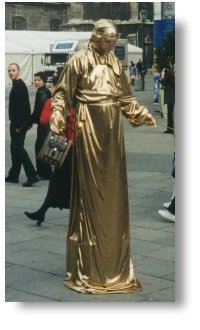
The next day we chose an optional tour that included the Vienna Opera House, Art Museum of Vienna, and Prater Park, an amusement park given to the Austrian people by Emperor Franz-Joseph as a place to have fun. The park is home to the Riesenrad, one of the oldest and largest Ferris Wheels, built in 1897. It became internationally recognized after the famous ride of Orson Welles and Joseph Cotton in the film, The Third Man. In the evening our tour group had a Grinzing dinner at a restaurant in the wine district. The afternoon and the next day we were on our own for touring and shopping in Vienna as we pleased. We chose to take the subway to do some shopping in the Ringstrasse area, taking in some of the street entertainment - a mime dressed in gold lam�, and a puppeteer. We found an ice cream shop, pastry shops, a few chocolate stores, and saw some beautiful jewelry made of Austrian crystal.
I wish we had worn a pedometer to keep track of how many miles we walked through The Netherlands, Germany and Austria, as it would be interesting to know the distance we covered on foot through these twenty-one villages, towns and cities.